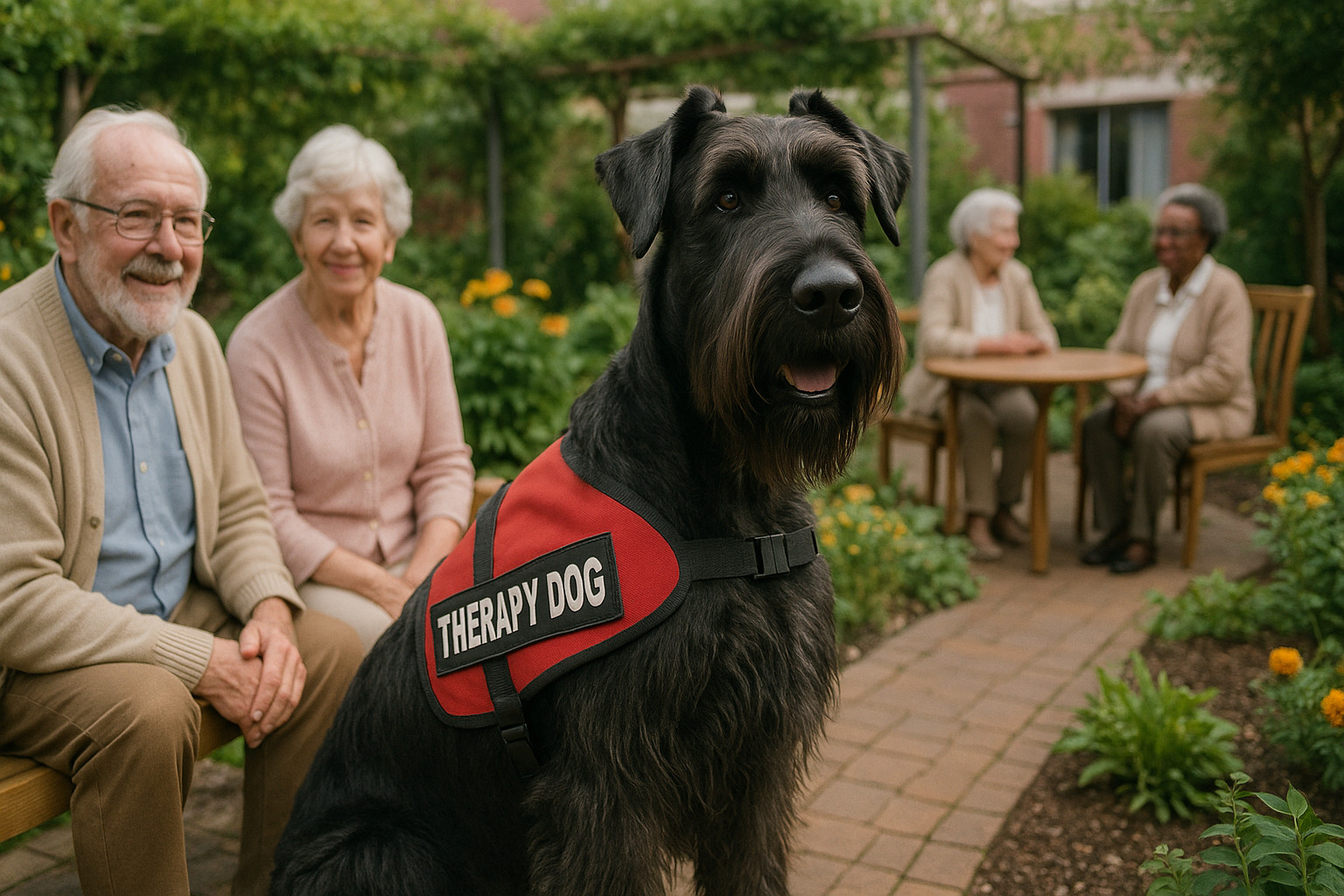Giant Schnauzer as a Therapy Dog
Register Your Dog

Giant Schnauzer as a Therapy Dog Overview
Giant Schnauzers are a distinguished breed known for their robust physique and loyal nature. Originally developed in Germany as herding and guarding dogs, they have gained popularity beyond their working roots for their abilities as companion animals. In recent years, the potential of the Giant Schnauzer as a therapy dog has garnered attention due to its blend of intelligence, sensitivity, and adaptability. This article explores the attributes and considerations relevant to the Giant Schnauzer fulfilling a therapy role.
Understanding the Therapy Dog Role
Therapy dogs play a crucial role in improving the emotional and psychological well-being of individuals in various settings. Unlike service dogs, which are trained to perform specific tasks for individuals with disabilities, therapy dogs provide comfort and affection to people in hospitals, nursing homes, schools, and more. The role demands a dog to be gentle, well-mannered, and non-reactive to various stimuli.
Physical Appearance and Energy Level
The Giant Schnauzer’s imposing physical appearance is complemented by a keen intelligence and high energy level. Standing between 23.5 to 27.5 inches at the shoulder and weighing between 65 to 90 pounds, they require regular physical activity to channel their exuberance positively. In therapy settings, this energy can be both an asset and a limitation.
- Assets:
- Their energetic nature can be uplifting in active therapy environments and encourage engagement.
- Their size and presence often provide a sense of security and comfort.
- Limitations:
- They may become restless if not sufficiently exercised, which could impact their ability to remain calm and composed during therapy sessions.
- Space constraints in certain therapy environments might not suit larger breeds.
Personality and Emotional Intelligence
Giant Schnauzers are known for their strong personality and acute emotional intelligence. They are affectionate, devoted, and form strong bonds with humans, which are essential qualities for a therapy dog.
- Empathy and Sensitivity:
- They possess a keen sense of emotional awareness, enabling them to sense and respond to human emotions effectively.
- Their natural protectiveness can translate into a strong intuition in understanding emotional needs.
- Calmness under Pressure:
- While generally calm, their inherent protective instincts require careful training to avoid over-guardianship in calming settings.
Environments Where Giant Schnauzer Excels
Their alert and attentive nature positions them well in environments that benefit from keen observation skills and gentle presence.
- Hospitals and Rehabilitation Centers:
- The breed’s social confidence allows them to easily interact with patients and staff, providing comfort through their steadfast presence.
- Schools and Educational Institutions:
- They excel in environments where structured interaction strategies are employed, making them particularly effective in social learning situations.
Common Therapy Settings
The adaptability of Giant Schnauzers opens several avenues for them to succeed as therapy dogs across various settings, such as:
- Nursing Homes:
- Their gentle temperament and patience make them ideal companions for elderly individuals, offering companionship and a sense of security.
- Physical Rehabilitation Facilities:
- Their energy can be inspiring during physical therapy exercises, encouraging patient participation and offering motivational support.
Interactions with Different Populations
Giant Schnauzers’ interactions with diverse populations are influenced by their temperament and adaptability.
- With Children:
- Children benefit from their playful yet gentle demeanor, though supervision is key to ensure playfulness does not overwhelm smaller kids.
- With the Elderly:
- The breed’s calm and comforting nature can have a soothing effect on older individuals, providing nonintrusive companionship and emotional upliftment.
Health and Wellness Factors
Maintaining the health and wellness of a Giant Schnauzer is critical to their successful participation as a therapy dog.
- Lifespan and Common Health Issues:
- With a lifespan of about 12 to 15 years, they can assist as a therapy dog for a long duration. Common health issues include hip dysplasia and certain skin conditions, which require diligent care.
- Maintenance and Care Needs:
- Their wiry coat demands regular grooming to maintain hygiene and prevent matting, especially crucial when interacting in health-sensitive environments.
Training and Certification Readiness
Giant Schnauzers possess the intelligence and drive necessary for rigorous training, making them viable candidates for therapy certification.
- Learning Style and Responsiveness:
- Their smart and responsive nature allows them to quickly learn commands and adapt to varied therapy environments.
- Handling Social and Emotional Stimuli:
- With targeted training, they can be taught to manage high-stimulation environments without becoming anxious or reactive, allowing them to focus on therapy tasks efficiently.
Strengths, Limitations, and Ideal Roles for Giant Schnauzer
Understanding the Giant Schnauzer’s strengths and limitations is vital in placing them in appropriate therapy roles.
- Strengths:
- Eager to please and quick learners, they bond closely with handlers and participants alike, often excelling in environments that challenge cognitive and social engagement.
- Limitations:
- Without proper exercise and mental stimulation, they may become bored or restless, which can hinder therapy effectiveness.
- Ideal Roles:
- Best suited for dynamic environments where their energy can be harnessed positively and where space permits them to move around freely.
Final Thoughts
The Giant Schnauzer, with its combination of intelligence, loyalty, and gentle nature, holds significant potential as a therapy dog. Their distinctive physical and emotional traits can be effectively harnessed in diverse therapy settings, provided their care and training are adeptly managed. With an appropriate environment and guidance, they can offer invaluable support and companionship, enhancing therapeutic outcomes across a spectrum of needs.
—
Key Takeaways for the Giant Schnauzer as a Therapy Dog
- Best suited for: Dynamic and engaging therapy settings that accommodate large breeds, such as hospitals and rehabilitation centers.
- Not ideal for: Space-constrained environments or contexts needing lower-energy dogs.
- Temperament highlights: Affectionate, emotionally intelligent, and energetic.
- Care and health notes: Requires regular grooming and exercise; vigilant management of health issues like hip dysplasia.
- Therapy environments where they shine: Hospitals, nursing homes, schools, and rehabilitation facilities.











